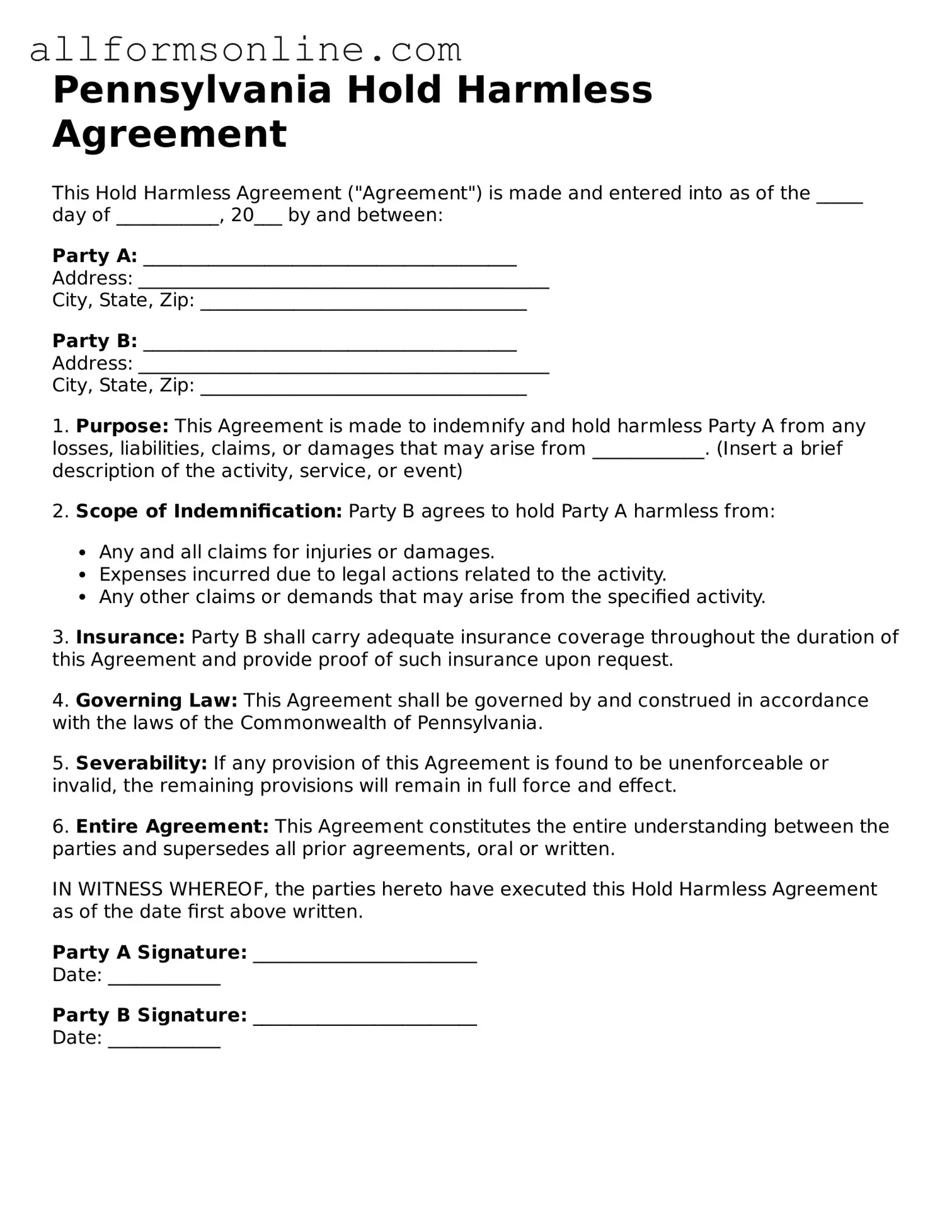What is a Pennsylvania Hold Harmless Agreement?
A Hold Harmless Agreement is a legal document that protects one party from liability or claims for damages that may arise during a specific activity or event. In Pennsylvania, this agreement is often used in various contexts, such as construction projects, recreational activities, or rental agreements, to ensure that one party does not hold the other responsible for any injuries or damages incurred during the activity.
Who typically uses a Hold Harmless Agreement in Pennsylvania?
Various individuals and organizations use Hold Harmless Agreements in Pennsylvania. Common users include property owners, contractors, event organizers, and businesses. For instance, if a contractor is hired to perform work on a property, the property owner may require the contractor to sign a Hold Harmless Agreement to protect themselves from any potential liability arising from the contractor's work.
What are the key components of a Hold Harmless Agreement?
A typical Hold Harmless Agreement includes several essential components. These include the names of the parties involved, a clear description of the activity or event, the scope of the indemnification, and any limitations on liability. Additionally, it may outline the responsibilities of each party and any applicable insurance requirements. Clarity in these components is crucial to ensure enforceability.
Is a Hold Harmless Agreement legally binding in Pennsylvania?
Yes, a Hold Harmless Agreement can be legally binding in Pennsylvania, provided it meets certain criteria. The agreement must be clear, voluntary, and signed by both parties. Courts generally uphold these agreements unless they are deemed unconscionable or against public policy. It is advisable to consult with a legal professional to ensure that the agreement is properly drafted.
Can a Hold Harmless Agreement protect against gross negligence or willful misconduct?
In Pennsylvania, Hold Harmless Agreements typically do not protect against gross negligence or willful misconduct. Courts often view such actions as contrary to public policy. Therefore, if a party engages in reckless behavior or intentionally causes harm, the Hold Harmless Agreement may not provide protection. It is essential to understand the limitations of such agreements.
How can one enforce a Hold Harmless Agreement?
Enforcement of a Hold Harmless Agreement usually requires demonstrating that the agreement was valid and that the parties adhered to its terms. If a dispute arises, parties may need to take the matter to court. It is crucial to keep a copy of the signed agreement and any related documentation to support your case. Legal counsel can assist in navigating the enforcement process.
Are there any risks associated with signing a Hold Harmless Agreement?
Yes, there are risks involved in signing a Hold Harmless Agreement. By signing, you may be waiving your right to seek compensation for injuries or damages that occur during the specified activity. It is important to fully understand the implications of the agreement before signing. Consulting with a legal expert can provide clarity and help you make an informed decision.
Can a Hold Harmless Agreement be modified after it is signed?
Yes, a Hold Harmless Agreement can be modified after it is signed, but both parties must agree to the changes. Any modifications should be documented in writing and signed by both parties to ensure they are enforceable. It is advisable to seek legal advice when making changes to ensure that the new terms are clear and legally binding.
Where can I find a Hold Harmless Agreement template for Pennsylvania?
Hold Harmless Agreement templates can be found through various online legal resources, law firms, or local government websites. However, it is essential to ensure that any template used complies with Pennsylvania laws and is tailored to your specific needs. Consulting with a legal professional can help ensure that the agreement is appropriate for your situation.
